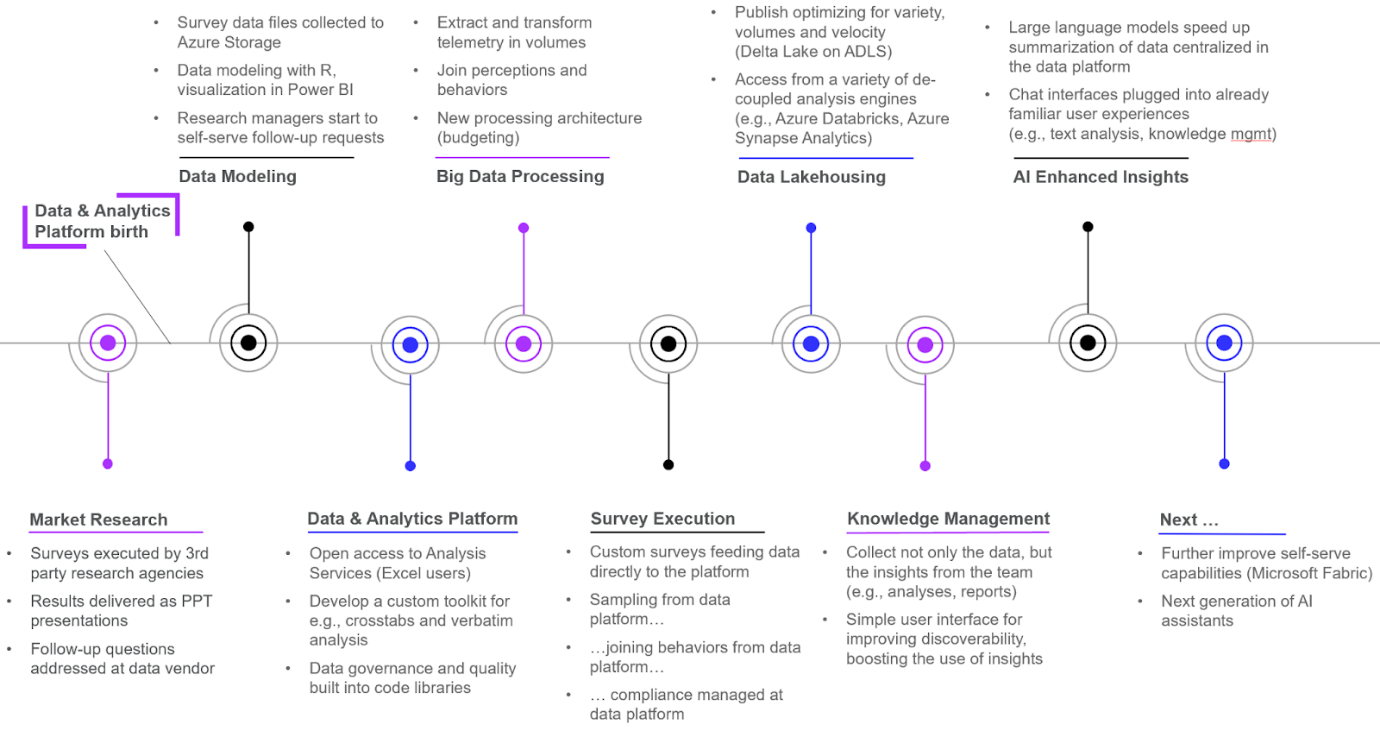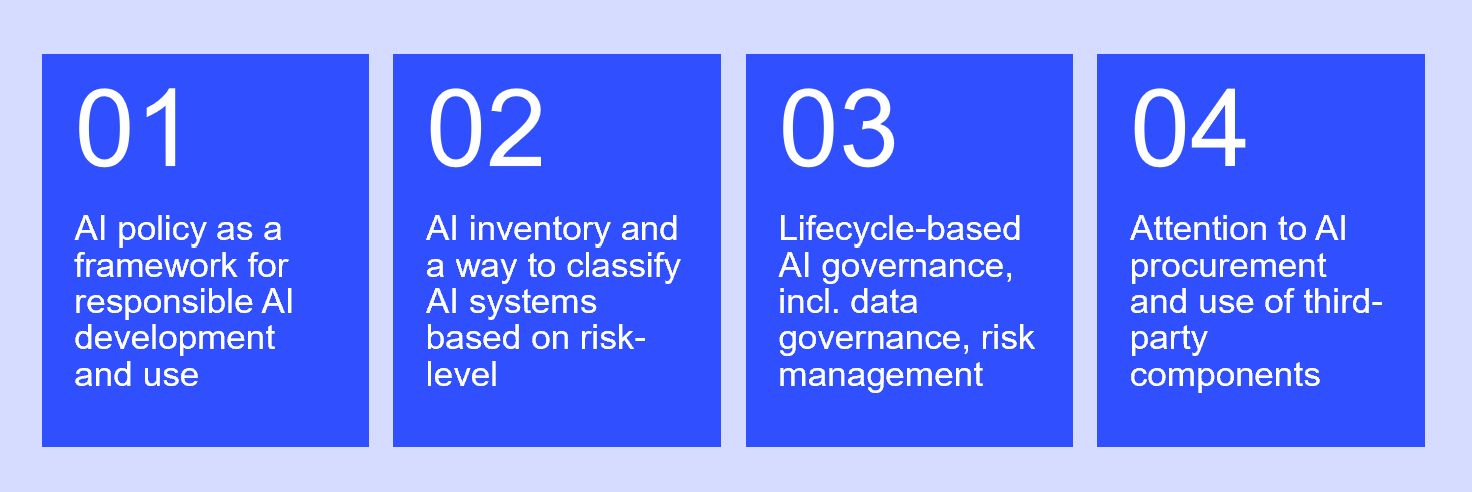AI // Data Strategy // Data & AI
Contact Us → Contact Us →Siili's bi-annual Data Leaders' Roundtable event took place last month, gathering decision makers in data, AI, and analytics. The discussion, facilitated by Siili’s AI Business Design Director Caroline Liu, focused on the complexities of modern data environments and the upcoming changes brought about by the AI and Data Acts.
Data and AI leaders face growing regulative demands and need to get ready by cultivating a compliant-by-design data innovation culture. The main takeaway from the Data Leader’s Roundtable event? Today's data challenge is more about communication and less about algorithms or numbers. In fact, it is really a people challenge.
At the event, we heard excellent presentations from Meeri Haataja, Matti Uronen, and Iiro Ritola, followed by very interesting discussions among our roundtable participants.
Building data capabilities for tomorrow’s business
The opening presentation from Siili’s Data Consultant, Iiro Ritola, and Microsoft’s Research Data Architect, Matti Uronen unpacked the complexities of modern data environments, from managing large volumes of data to ensuring proper governance. Iiro and Matti’s talk unfolded a ten-year data journey from the perspective of Microsoft’s Research and Insights team, and offered unique insights into how they navigated challenges with global solutions across product development and business operations.
A perspective of a data leader
Even with powerful tools like Power BI at their disposal, Microsoft recognizes the need for more intuitive user interfaces to facilitate data discovery and increase user engagement. In practice, this integration necessitates clear communication and trust between stakeholders and development teams. By fostering a shared understanding of the business value of data, data analysts and engineers can align their objectives, delivering data in a manner that best serves end-user needs.
Microsoft approaches these situations as fit-for-purpose. It describes the optimal solution to deliver data in a technical scale that fits the business purpose. The scale is defined by its individual parameters rather than focusing on the conformity of the bigger platform. If development team understand the business value and objectives, they could offer best fitting technical solutions. For instance, company may benefit more from building multiple small scoped data repository in incremental approach than one massive one at once.

Data is a valuable currency, and creating a solid data infrastructure becomes key. However, this endeavor is not without its challenges. With the rising costs associated with building and maintaining extensive data systems, it's essential for companies to carefully consider their needs and tailor their data infrastructure accordingly.
The main point to consider is the scope of the data infrastructure. Companies must ask themselves what the end goal of their data collection is and how it aligns with their business use case. It's about finding that sweet spot where the infrastructure is robust enough to support operations without being excessively large or costly. The goal is not to aim for the largest or most complex system from the outset. Instead, companies should focus on a scalable model that can grow with their needs in align with the business strategy.
Utilizing data in transforming your business: Easier said than done
Over the past decade, we've witnessed a common trend of big data adoption, with a focus on engineering and data architecture. But as we progress, most companies now find themselves with data stored across various platforms, and the challenge has shifted. The question is no longer just about the logistics of data storage but about utilization—how to integrate data into the daily workflow to ensure it generates insights, informs decisions, and becomes part of the fabric of an organization.
The utilization of data should transcend beyond mere reports for analysts. It should infiltrate the daily decision-making processes of every employee, guiding actions with data-driven insights. This requires a concerted effort beyond the technical realm; it calls for orchestrating an organization-wide advocacy for data.
The conversation extended to different sectors, including FinTech, where companies shared their experiences. Initially, the engineering departments may focus solely on fulfilling data requests, but ultimately, the true value of data infrastructure lies in its application within the business context. It's not just about building an infrastructure; it's about creating an environment where data is not just present but actively contributing to the strategic and operational prowess of the company.
Traditional industries and the journey towards data maturity
The discussion then shifted to more traditional companies which typically find themselves in the intermediate stages of data maturity, grappling with how to effectively incorporate data into their day-to-day operations. The conversation highlighted the need for decentralized data ownership, advocating for co-ownership by business stakeholders, or even a comprehensive data governance model.
Effective data governance is fundamental, and data storage and management must align with business strategy. However, many organizations still lack a robust internal structure for data governance, often reducing it to mere compliance management. The importance of a functioning data governance system cannot be overstated, as it is the backbone of data utilization and AI implementation.
Lastly, the roundtable addressed the challenges associated with AI POCs. Companies must ensure that AI initiatives are not only technologically sound but also align with business objectives and are prepared for the organizational changes they may introduce.
In sum, today's data challenges are as much about people and communication as they are about technology. Building a data-centric culture is not just a matter of mastering algorithms—it's about establishing a dialogue that bridges the gap between data science and business strategy, ensuring that data governance and AI advancements truly serve the company's long-term goals and are aligned with policies.
Understanding the EU Data Act and AI Act
The EU Data Act and AI Act could feel like a giant riddle, but Meeri Haataja, CEO and founder of Saidot, clarified it in plain language. Her talk was a lightbulb moment, revealing how businesses can stay ahead without getting tangled in regulatory webs. Meeri offered an in-depth exploration of the acts’ tangible effects on businesses, demystifying its implications and delivering actionable insights the new regulatory landscape
Among other things, there is understandable uncertainty about how both the Data Act and AI Act can impact companies, and possibly bridge the competitive gap between big players and SMEs. This could open opportunities for smaller businesses and startups to access and leverage valuable data, thus fostering competition.
EU AI Act
- Focuses specifically on AI and aims to be the world's first comprehensive AI law.
- Categorizes AI applications based on risk. High-risk applications, like AI for hiring decisions, will face stricter rules to ensure they don't discriminate or unfairly impact people.
- Bans certain risky AI uses, like social scoring systems and using facial recognition for mass surveillance.
EU Data Act
- Deals more broadly with data governance, aiming to create a fairer and more competitive data market in Europe.
- Doesn't directly regulate AI, but existing data protections within the Act will apply to any AI that uses personal information.
- Focuses on making data sharing between businesses and sectors easier, while still protecting user privacy.
These regulations are part of the EU's plan to promote responsible innovation in AI and data use. They introduce new regulatory landscapes that bring a mix of opportunities and challenges for businesses. These regulations aim to harness the power of data and artificial intelligence (AI) while ensuring safety, transparency, and respect for fundamental rights. Here's a closer look at the uncertainties, the importance of compliance, and the role of talent and education in aligning with these changes.
-
Uncertainties
Companies face uncertainties with these regulations due to the complexity of defining AI and the rapid pace of technological development. The AI Act, for example, aims to regulate AI by classifying systems according to their risk levels, with strict requirements for high-risk categories and significant fines for violations. However, defining what constitutes AI is challenging and requires a balance between regulating potential harms and not stifling innovation. The dynamic nature of technology also raises concerns about the long-term effectiveness of these regulations.
-
Managing compliance
To manage compliance, companies must develop robust Data/AI governance frameworks. This involves understanding the regulatory requirements, such as those outlined in the AI Act, which mandates a clear inventory and risk classification of AI models. Organizations need to assess whether they use AI models, classify them by risk, and comply with the necessary requirements, including registration for high-risk models and ensuring data governance and cybersecurity .
Realizing the necessity for diverse expertise in the Data and AI space is crucial for adapting company culture to these regulatory changes. This diversity helps in understanding the complex landscape of Data/AI governance and ensuring that the organization's practices align with the new regulations.
-
The importance of talent and education
Continuous education on Data and AI topics is essential for employees to navigate these regulatory landscapes effectively. Companies should encourage and enable their employees to take ownership of Data/AI subjects, enhancing their awareness and understanding. This could involve designing internal pathways for learning and growth in these areas.
When engaging third-party vendors, especially those outside the EU, their knowledge of and compliance with EU regulations on data and AI becomes a significant advantage. This ensures that the services they provide align with the EU's stringent regulatory standards, helping companies to maintain compliance and leverage AI safely and effectively .
In summary, the EU Data Act and AI Act represent significant steps towards regulating the digital and AI landscapes. Aligning with these regulations requires a proactive approach to governance, a commitment to continuous learning and adaptation, and the engagement of diverse expertise to ensure compliance and harness the benefits of AI and data in a responsible manner.
Meeri’s presentation on EU Data Act and EU AI Act sparked extensive discussions, with many participants pointing to leveraging this framework as an advantage rather than seeing it as an overly burdensome process.
Good practices from working with AI Act early adopters
Meeri shared a blueprint for responsible AI adoption.

- AI policy as a framework for responsible AI development and use. Establishing a comprehensive AI policy provides a structured approach to develop and use AI responsibly. Such a policy should serve as a guiding framework that aligns AI initiatives with ethical standards and societal values.
- AI inventory and a way to classify AI systems based on risk level. Creating an inventory of AI systems helps in organizing and managing them effectively. Classifying these systems based on the level of risk they pose ensures that appropriate oversight and governance mechanisms can be implemented.
- Lifecycle-based AI governance, including data governance and risk management. Implementing AI governance throughout the entire lifecycle of AI systems, from conception to deployment, is crucial. This includes managing the data that fuels AI and identifying and mitigating risks at each stage.
- Attention to AI procurement and use of third-party components. Careful consideration and due diligence are necessary when procuring AI solutions and using third-party components. This practice ensures that the AI solutions are trustworthy and that the procurement process aligns with the organization's standards and regulations.
Key takeaways discussion points from the Data Leaders’ Roundtable event
The discussions that followed the presentations were rich with aha moments. We discussed how fostering a culture that embraces data helps everyone from the ground up. Key takeaways included the importance of marrying technical fixes with a human touch to truly leverage data’s potential.
✺ Data-driven mindset. It’s not just about algorithms and numbers; it’s about empowering the people who wield data for their work. Let’s nurture data literacy across organizations!
✺ Decentralization of ownership. To make the data-driven mindset happen, companies need to decentralize the data ownership, and then have a functioning data governance in place.
✺ Talent strategy. The evolving landscape of data management demands a holistic approach. Beyond data engineers and data scientists, companies must consider additional roles to ensure effective data handling, e.g. Data Governance Specialists, Change Management Professionals, etc.
✺ Navigating the EU Data Act and EU AI Act. With these new regulations on the horizon, organizations face exciting challenges. How can we design compliance experiences? Perhaps a bonus system for adherence? Let’s innovate while staying compliant!
.png)
